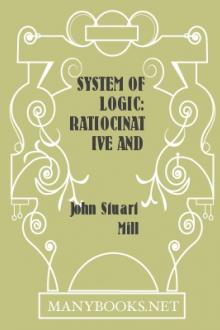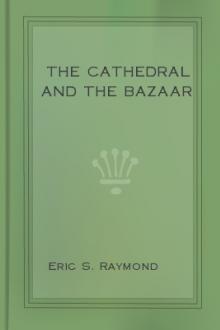A System of Logic: Ratiocinative and Inductive, John Stuart Mill [best books to read now .txt] 📗

- Author: John Stuart Mill
- Performer: -
Book online «A System of Logic: Ratiocinative and Inductive, John Stuart Mill [best books to read now .txt] 📗». Author John Stuart Mill
§ 4. Sir William Hamilton holds as I do, that inconceivability is no criterion of impossibility. "There is no ground for inferring a certain fact to be impossible, merely from our inability to conceive its possibility." "Things there are which may, nay must, be true, of which the understanding is wholly unable to construe to itself the possibility."[43] Sir William Hamilton is however a firm believer in the à priori character of many axioms, and of the sciences deduced from them; and is so far from considering those axioms to rest on the evidence of experience, that he declares certain of them to be true even of Noumena—of the Unconditioned—of which it is one of the principal aims of his philosophy to prove that the nature of our faculties debars us from having any knowledge. The axioms to which he attributes this exceptional emancipation from the limits which confine all our other possibilities of knowledge; the chinks through which, as he represents, one ray of light finds its way to us from behind the curtain which veils from us the mysterious world of Things in themselves,—are the two principles, which he terms, after the schoolmen, the Principle of Contradiction, and the Principle of Excluded Middle: the first, that two contradictory propositions cannot both be true; the second, that they cannot both be false. Armed with these logical weapons, we may boldly face Things in themselves, and tender to them the double alternative, sure that they must absolutely elect one or the other side, though we may be for ever precluded from discovering which. To take his favourite example, we cannot conceive the infinite divisibility of matter, and we cannot conceive a minimum, or end to divisibility: yet one or the other must be true.
As I have hitherto said nothing of the two axioms in question, those of Contradiction and of Excluded Middle, it is not unseasonable to consider them here. The former asserts that an affirmative proposition and the corresponding negative proposition cannot both be true; which has generally been held to be intuitively evident. Sir William Hamilton and the Germans consider it to be the statement in words of a form or law of our thinking faculty. Other philosophers, not less deserving of consideration, deem it to be an identical proposition; an assertion involved in the meaning of terms; a mode of defining Negation, and the word Not.
I am able to go one step with these last. An affirmative assertion and its negative are not two independent assertions, connected with each other only as mutually incompatible. That if the negative be true, the affirmative must be false, really is a mere identical proposition; for the negative proposition asserts nothing but the falsity of the affirmative, and has no other sense or meaning whatever. The Principium Contradictionis should therefore put off the ambitious phraseology which gives it the air of a fundamental antithesis pervading nature, and should be enunciated in the simpler form, that the same proposition cannot at the same time be false and true. But I can go no farther with the Nominalists; for I cannot look upon this last as a merely verbal proposition. I consider it to be, like other axioms, one of our first and most familiar generalizations from experience. The original foundation of it I take to be, that Belief and Disbelief are two different mental states, excluding one another. This we know by the simplest observation of our own minds. And if we carry our observation outwards, we also find that light and darkness, sound and silence, motion and quiescence, equality and inequality, preceding and following, succession and simultaneousness, any positive phenomenon whatever and its negative, are distinct phenomena, pointedly contrasted, and the one always absent where the other is present. I consider the maxim in question to be a generalization from all these facts.
In like manner as the Principle of Contradiction (that one of two contradictories must be false) means that an assertion cannot be both true and false, so the Principle of Excluded Middle, or that one of two contradictories must be true, means that an assertion must be either true or false: either the affirmative is true, or otherwise the negative is true, which means that the affirmative is false. I cannot help thinking this principle a surprising specimen of a so-called necessity of Thought, since it is not even true, unless with a large qualification. A proposition must be either true or false, provided that the predicate be one which can in any intelligible sense be attributed to the subject; (and as this is always assumed to be the case in treatises on logic, the axiom is always laid down there as of absolute truth). "Abracadabra is a second intention" is neither true nor false. Between the true and the false there is a third possibility, the Unmeaning: and this alternative is fatal to Sir William Hamilton's extension of the maxim to Noumena. That Matter must either have a minimum of divisibility or be infinitely divisible, is more than we can ever know. For in the first place, Matter, in any other than the phenomenal sense of the term, may not exist: and it will scarcely be said that a non-entity must be either infinitely or finitely divisible.[44] In the second place, though matter, considered as the occult cause of our sensations, do really exist, yet what we call divisibility may be an attribute only of our sensations of sight and touch, and not of their uncognizable cause. Divisibility may not be predicable at all, in any intelligible sense, of Things in themselves, nor therefore of Matter in itself; and the assumed necessity of being either infinitely or finitely divisible, may be an inapplicable alternative.
On this question I am happy to have the full concurrence of Mr. Herbert Spencer, from whose paper in the Fortnightly Review I extract the following passage. The germ of an idea identical with that of Mr. Spencer may be found in the present chapter, about a page back, but in Mr. Spencer it is not an undeveloped thought, but a philosophical theory.
"When remembering a certain thing as in a certain place, the place and the thing are mentally represented together; while to think of the non-existence of the thing in that place, implies a consciousness in which the place is represented, but not the thing. Similarly, if instead of thinking of an object as colourless, we think of its having colour, the change consists in the addition to the concept of an element that was before absent from it—the object cannot be thought of first as red and then as not red, without one component of the thought being totally expelled from the mind by another. The law of the Excluded Middle, then, is simply a generalization of the universal experience that some mental states are directly destructive of other states. It formulates a certain absolutely constant law, that the appearance of any positive mode of consciousness cannot occur without excluding a correlative negative mode; and that the negative mode cannot occur without excluding the correlative positive mode: the antithesis of positive and negative being, indeed, merely an expression of this experience. Hence it follows that if consciousness is not in one of the two modes it must be in the other."[45]
I must here close this supplementary chapter, and with it the Second Book. The theory of Induction, in the most comprehensive sense of the term, will form the subject of the Third.
[1] As Sir William Hamilton has pointed out, "Some A is not B" may also be converted in the following form: "No B is some A." Some men are not negroes; therefore, No negroes are some men (e.g. Europeans).
[2]
[3] His conclusions are, "The first figure is suited to the discovery or proof of the properties of a thing; the second to the discovery or proof of the distinctions between things; the third to the discovery or proof of instances and exceptions; the fourth to the discovery, or exclusion, of the different species of a genus." The reference of syllogisms in the last three figures to the dictum de omni et nullo is, in Lambert's opinion, strained and unnatural: to each of the three belongs, according to him, a separate axiom, co-ordinate and of equal authority with that dictum, and to which he gives the names of dictum de diverso for the second figure, dictum de exemplo for the third, and dictum de reciproco for the fourth. See part i. or Dianoiologie, chap. iv. § 229 et seqq. Mr. Bailey, (Theory of Reasoning, 2nd ed. pp. 70-74) takes a similar view of the subject.
[4] Since this chapter was written, two treatises have appeared (or rather a treatise and a fragment of a treatise), which aim at a further improvement in the theory of the forms of ratiocination: Mr. De Morgan's "Formal Logic; or, the Calculus of Inference, Necessary and Probable;" and the "New Analytic of Logical Forms," attached as an Appendix to Sir William Hamilton's Discussions on Philosophy, and at greater length, to his posthumous Lectures on Logic.
In Mr. De Morgan's volume—abounding, in its more popular parts, with valuable observations felicitously expressed—the principal feature of originality is an attempt to bring within strict technical rules the cases in which a conclusion can be drawn from premises of a form usually classed as particular. Mr. De Morgan observes, very justly, that from the premises Most Bs are Cs, most Bs are As, it may be concluded with certainty that some As are Cs, since two portions of the class B, each of them comprising more than half, must necessarily in part consist of the same individuals. Following out this line of thought, it is equally evident that if we knew exactly what proportion the "most" in each of the premises bear to the entire class B, we could increase in a corresponding degree the definiteness of the conclusion. Thus if 60 per cent of B are included in C, and 70 per cent in A, 30 per cent at least must be common to both; in other words, the number of As which are Cs, and of Cs which are As, must be at least equal to 30 per cent of the class B. Proceeding on this conception of "numerically definite propositions," and extending it to such forms as these:—"45 Xs (or more) are each of them one of 70 Ys," or "45 Xs (or more) are no one of them to be found among 70 Ys," and examining what inferences admit of being drawn from the various combinations which may be made of premises of this description, Mr. De Morgan establishes universal formulæ for such inferences; creating for that purpose not only a new technical language, but a formidable array of symbols analogous to those of algebra.
Since it is undeniable that inferences, in the cases





Comments (0)